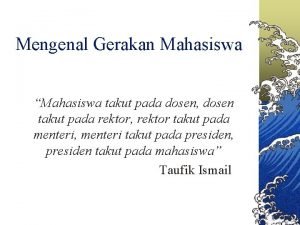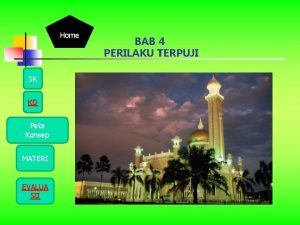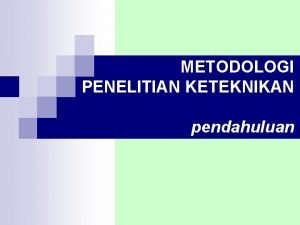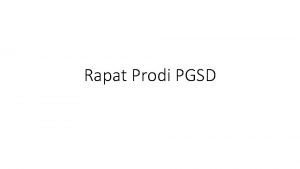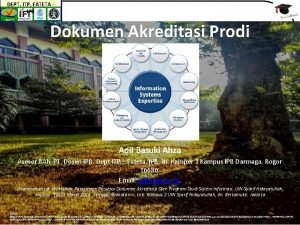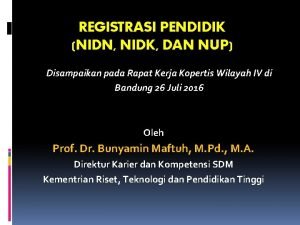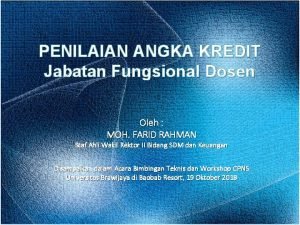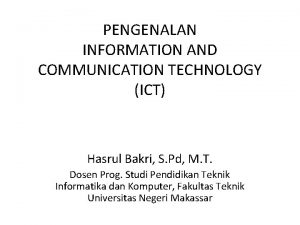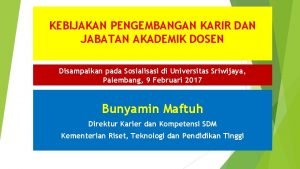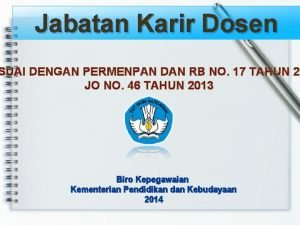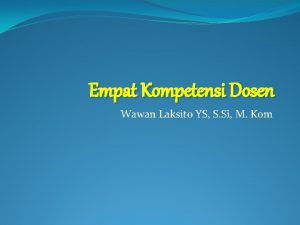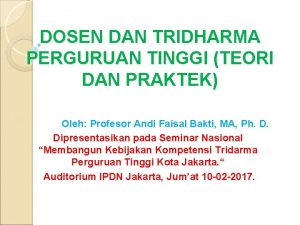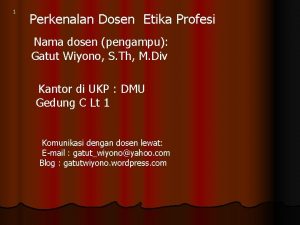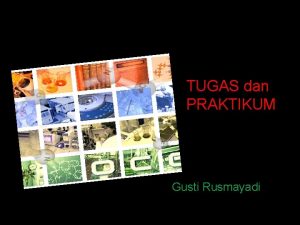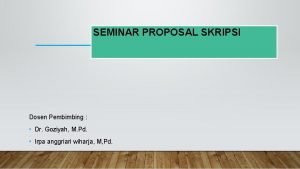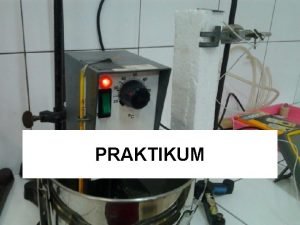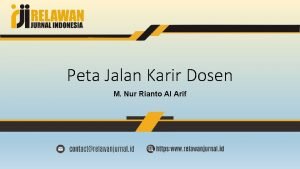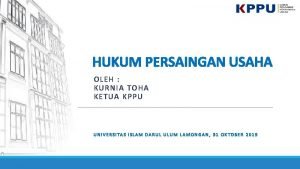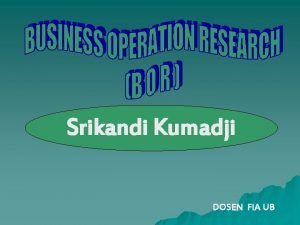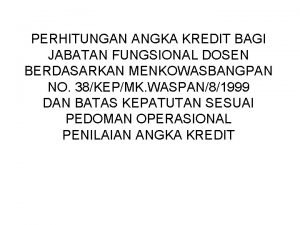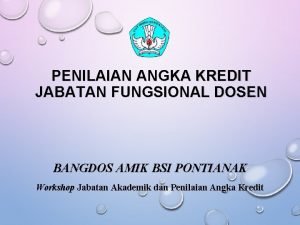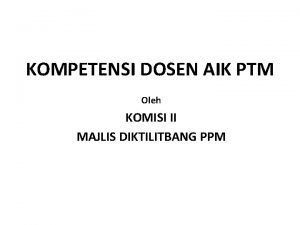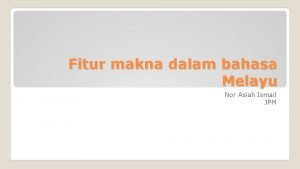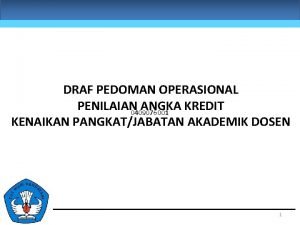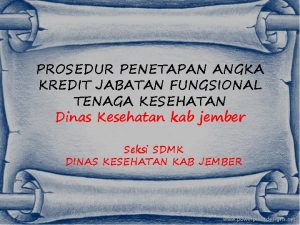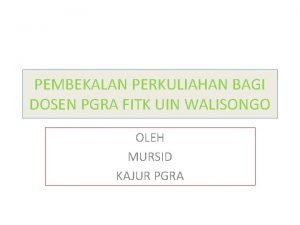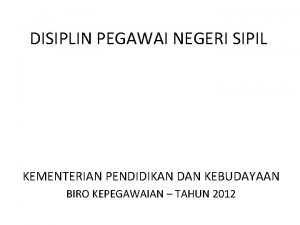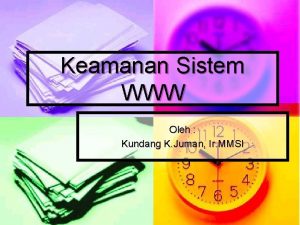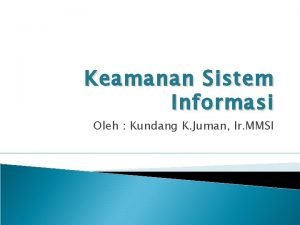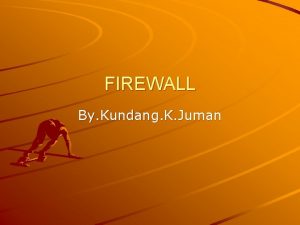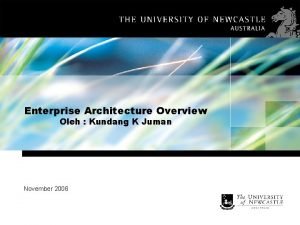Digital Network Pertemuan14 Dosen Kundang K Juman Prodi


















































- Slides: 50

Digital Network Pertemuan-14 Dosen : Kundang K Juman Prodi Teknik Informatika , Fakultas Imu Komputer

Integrated Services Digital Network u Public networks are used for a variety of services – Public Switched Telephone Network – Private Lines (leased) – Packet Switched Data Networks – Circuit Switched Data networks 2

ISDN u Users have a variety of equipment to connect to public networks – Telephones – Private Branch Exchanges – Computer Terminals or PCs – Mainframe Computers u. A variety of physical interfaces and access procedures are required for connection 3

ISDN u The telephone network has evolved into a digital one with digital exchanges and links u The signalling system has become a digital message-oriented common channel signalling system (SS#7) u The term ‘Integrated Digital Network’ is used to describe these developments 4

ISDN u The Public Switched Telephone network is still analogue from the subscriber to the local exchange u The need has arisen to extend the digital network out to subscribers and to provide a single standardised interface to all different users of public networks u ISDN fulfils that need 5

Integrated Services Digital Network Packet switched network Telephone Circuit switched network Data terminal PBX Alarm LAN Customer ISDN Interface ISDN central office ‘Digital pipe’ Databases Other Networks & services 6

ISDN u In Practice there are multiple networks providing the service nationally u The user however, sees a single network 7

Benefits to Subscribers u Single access line for all services u Ability to tailor service purchased to suit needs u Competition among equipment vendors due to standards u Availability of competitive service providers 8

Architecture Integrated Digital Network Common physical interface ISDN central office Digital circuitswitched backbone Packet-switched network ISDN subscriber loop Basic 2 B+D Primary 30 B+D Network-based processing services 9

ISDN Standards u Contained in the I-series recommendations u Issued by CCITT (now ITU-T) u Six main groupings I. 100 to I. 600 series u I. 100 series - General Concepts u I. 200 series - Service Capabilities u I. 300 series - Network Aspects u I. 400 series - User-Network Interfaces u I. 500 series - Internetwork Interfaces u I. 600 series - Maintenance Principles 10

ISDN Channels u The Digital pipe is made up of channels one of three types u B channel, D channel or H channel u Channels are grouped and offered as a package to users 11

B Channel B channel-64 kbps u B is basic user channel u – can carry digital data or PCM-encoded voice – or mixture of lower rate traffic. 12

B Channel u Four kinds of connection possible u Circuit-switched u Packet-switched - X. 25 u Frame mode - frame relay (LAPF) u Semipermanent - equivalent to a leased line 13

D Channel u. D Channel - 16 or 64 kbps u Carries signalling information to control circuit-switched calls on B channels u Can also be used for packet switching or low-speed telemetry 14

H Channel u Carry user information at higher bit rates 384 kbps or 1536 kbps or 1920 kbps u Can be used as a high-speed trunk u Can also be subdivided as per user’s own TDM scheme u Uses include high speed data, fast facsimile, video, high-quality audio 15

ISDN Channels and their Applications 16

ISDN Channel Groupings u Basic Access Õ two 64 kbps B channels Õ plus one 16 kbps D channel u B channels can be used for voice and data u simultaneous calls to separate destinations supported u D channel used for signalling and also for data using X. 25 17

ISDN Basic Access u Intended for small business and residential use u A single physical interface is provided u Data rate is 144 kbps plus 48 kbps overhead bits totalling 192 kbps u Most existing subscriber loops can support basic access 18

ISDN Primary Access u Intended for users with greater capacity requirements u Example would be a digital PBX u Two standards exist – 1. 544 Mbps American – 2. 048 Mbps European 19

ISDN Primary Access u Typically it is structured as 30 B channels plus one 64 kbps D channel (Europe) u Can also be structured as H channels – 5 H 0 +D for a 2. 048 Mbps interface – or 1 H 12 +D 20

ISDN Frame Structure Basic Rate Access 48 bits in 250 usec TE to NT FL B 1 F LD L L a B 2 LDL B 1 LDL B 2 LDL FL B 1 F EDA N a B 2 E DM B 1 ED S B 2 EDL 8 bits F= Framing bit L = dc balancing bit E = D-echo channel bit A = Activation bit NT to TE Fa = Auxiliary Framing bit N = opposite of Fa M = multiframing bit B 1 = B channel bits B 2 = B channel bits D = D channel bits S = Spare bits 21

ISDN Contention Resolution u Several TE’s can share a single line u How is contention resolved? u B-channel Traffic – No contention as each channel dedicated to particular TE u. D - Channel used for data and control so requires a contention resolution mechanism 22

D Channel Contention u Incoming Traffic – LAPD protocol resolves contention u Outgoing Traffic – Multiple devices share D channel – Contention resolution algorithm required 23

D Channel Contention u Idle TEs sends binary 1 s on D channel u This means no signal (pseudoternery) u NT echos received binary value back as echo bit u When NT wishes to send on D channel, it listens to echo bits u If it hears a string of 1’s equal in length to a threshold value Xi, it may transmit u Otherwise it must wait 24

D Channel Contention u If two TE’s start transmitting simultaneously a collision occurs u This is detected by each TE by monitoring E bits u If E bits are identical to D bits sent then no collision u If discrepency detected TE stops and listens 25

D Channel Contention u Priority mechanisms based on threshold values – Control information has priority over user data – When TE has sent data its priority is lowered until other terminals transmit 26

D Channel Priorities u Control Information – Normal Priority X 1 =8 – Lower Priority X 1 =9 u User Data – Normal Priority X 2 =10 – Lower Priority X 2 =11 27

ISDN Primary Interface u Multiple channels multiplexed on single medium u Only point to point configuration is allowed u Typically supports a digital PBX and provides a synchronous TDM facility 28

ISDN Primary Access Frame Formats 125 micro-seconds 193 bits timeslot 1 Timeslot 24 timeslot 2 F 1 2 3 4 5 6 7 8 ………………. 1 2 3 4 5 6 7 8 Interface at 1. 544 Mbps 125 micro-seconds 256 bits timeslot 0 Framing Channel 1 2 Timeslot 31 timeslot 1 3 4 5 6 7 8 1 2 3 4 5 6 7 8 ………………. Interface at 2. 048 Mbps 1 2 3 4 5 6 7 8 29

User Access u Defined using two concepts – Functional groupings of equipment – Reference points to separate functional groupings 30

Typical User Access Layout ISDN NT Tele phone 2 -wire Subscriber Loop 4 -wire S-bus PC with ISDN Interface Card Integrated Voice/data Terminal User/network Interface Up to 8 devices point to multi-point mode 31

ISDN Protocol Architecture Application Presentation Session End-end user signalling Transport Network I. 451/Q. 931 X. 25 for further call control packet level study Datalink LAPD (Q 921) Physical X. 25 packet level Frame Relay LAPB I. 430 basic interface + I. 431 primary interface 32

ISDN Data Link Layer u Link Access Protocol for the D channel (LAPD) defined for ISDN u Three applications are supported – Control Signalling – Packet Switching – Telemetry 33

Network Layer Above LAPD u Control Signalling – Call Control Protocol (I. 451 / Q. 931) » Establishes, maintains and terminates connections on B channels » Possibility of user - user control signalling above this layer 34

B-Channel u Uses – Circuit Switching – Semi-permanent circuits – Packet switching 35

B-Channel u Circuit Switching – Circuit is set up on B-channel on demand – D-channel call control protocol is used – Transparent full-duplex digital data path established between users – Layers 2 to 7 are not visible to ISDN or specified 36

B-Channel u Semipermanent circuit can be set up by prior agreement between users and network operator u Can be for indefinite time or at specified times during day or week u As with circuit switched connection, full duplex digital data path is established u Layers 2 to 7 are not visible to ISDN or specified 37

B-Channel Packet Switching u Circuit-switched connection is established between user and packet-switched node using D-channel call control protocol u The packet switching node can be integrated into ISDN or be a separate network u User then employs X. 25 layers 2 and 3 to establish virtual circuit to other user u Frame relay can also be used instead of 38 X. 25

D-Channel Packet Switching u Integrated X. 25 service can be accessed by D-Channel in addition to B-Channel u ISDN provides a semi-permanent connection to a packet switching node within ISDN u The X. 25 level 3 protocol is used for the packet layer u LAPD is used for the link layer 39

ISDN Call Control Protocol u Defined in recommendation I. 451/Q. 931 u Network layer protocol u Uses services of LAPD link layer u Specifies procedures for establishing, maintaining clearing connections on Bchannels sharing D-channel 40

ISDN Call Control Protocol u Message Types – Call establishment messages to set up a call – Call information messages during a call ( e. g. suspend a call and resume a call) – Call clearing messages to clear a call – Miscellaneous messages (congestion control, requesting supplementary services etc) 41

I. 451 Formats 8 7 6 5 4 3 2 1 Protocol Discriminator 0 0 Length of call reference value Flag Call reference value 0 Message type Mandatory and additional information elements General message format 42

LAPD u Provides two types of service – Unacknowledged information transfer » No guarantee of delivery » Frames with error are discarded – Acknowledged information transfer » Similar to HDLC » Flow and error control » Logical connection established prior to data transfer » Also called multiple-frame operation 43

LAPD Format Flag Service access point identifier 1 C/R 0 Terminal endpoint identifier Control Information 1 1 1 or 2 0 to 128 or 0 to 260 Frame Check Sequence 2 Flag 1 Length in octets 44

ISDN Physical Interface u There are no separate control circuits u Transmit and receive circuits carry data and control signals u Pseudoternery coding scheme is used for basic access signals – Voltage level is + or - 750 m. V – Data rate is 192 kbps u HDB 3 code is used for 2. 048 Mbps access u B 8 ZS code is used for 1. 544 Mbps access 45

ISDN INTERFACE PLUG PINOUT PIN 1 2 3 4 5 6 7 8 TERMINAL EQUIPMENT Power Source 3 Transmit Receive Transmit Power Sink 2 NETWORK TERMINATING EQUIPMENT Power Sink 3 Receive Transmit Receive Power Source 2 46

Broadband ISDN u Recommendations to support video services as well as normal ISDN services u Provides user with additional data rates – 155. 52 Mbps full-duplex – 155. 52 Mbps / 622. 08 Mbps – 622. 08 Mbps full-duplex u Exploits optical fibre transmission technology u Very high performance switches 47

B-ISDN Architecture TE BISDN Narrowband Capabilities LFC Broadband Capabilities User to Network Signalling TE = Terminal equipment LFC = Local function capabilities LFC TE Inter-exchange Signalling Capabilities 48

B-ISDN u ATM is specified for Information transfer across the user-network interface u Fixed size 53 octet packet with a 5 octet header u Implies that internal switching will be packet-based 49

BISDN Protocol Structure Plane management function Control Plane User Plane Higher Layers: protocols and functions Adaptation Layer ATM Layer Physical medium dependent Layer 50
 Mahasiswa takut pada dosen
Mahasiswa takut pada dosen Mengomentari buku
Mengomentari buku Peta konsep husnuzan
Peta konsep husnuzan Apa yang kalian tentang
Apa yang kalian tentang Kkni level 8
Kkni level 8 Spesialis kklp adalah
Spesialis kklp adalah Program kerja prodi pgsd
Program kerja prodi pgsd Akreditasi prodi di ipb
Akreditasi prodi di ipb Hubungan sosiologi dengan ilmu gizi
Hubungan sosiologi dengan ilmu gizi Nomor urut pendidik
Nomor urut pendidik Jabfung dosen
Jabfung dosen Ir hasrul bakri
Ir hasrul bakri Elearning radenintan.ac.id
Elearning radenintan.ac.id Angka kredit dosen
Angka kredit dosen Ap itu kalimat efektif
Ap itu kalimat efektif Pangkat dan golongan dosen
Pangkat dan golongan dosen 4 kompetensi dosen
4 kompetensi dosen Tridharma dosen
Tridharma dosen Pangkat dan golongan dosen
Pangkat dan golongan dosen Lore goethals
Lore goethals Skim penelitian adalah
Skim penelitian adalah Isdn dosen
Isdn dosen Perkenalan dosen
Perkenalan dosen Tugas dosen sebagai pengelola praktikum
Tugas dosen sebagai pengelola praktikum Puisi untuk dosen pembimbing
Puisi untuk dosen pembimbing Tugas dosen sebagai pengelola praktikum
Tugas dosen sebagai pengelola praktikum Peta karir menjadi dosen
Peta karir menjadi dosen Kurnia toha dosen ui
Kurnia toha dosen ui Langgeng wahyu santosa
Langgeng wahyu santosa Angka kredit dosen
Angka kredit dosen Dosen fia ub
Dosen fia ub Arlene fajutrao dosen
Arlene fajutrao dosen Angka kredit dosen
Angka kredit dosen Jenis jabatan fungsional
Jenis jabatan fungsional Tunjangan lektor
Tunjangan lektor Kompetensi dosen
Kompetensi dosen Jafung dosen
Jafung dosen Muka bantal makna denotatif
Muka bantal makna denotatif Angka kredit dosen
Angka kredit dosen Pedoman angka kredit dosen
Pedoman angka kredit dosen Pedoman angka kredit dosen
Pedoman angka kredit dosen Ikhtisar suatu pelajaran atau perkuliahan
Ikhtisar suatu pelajaran atau perkuliahan Siakad unikama dosen
Siakad unikama dosen Pns dosen
Pns dosen Yang dimaksud dengan kewargaan digital
Yang dimaksud dengan kewargaan digital E-commerce digital markets digital goods
E-commerce digital markets digital goods Digital data digital signals
Digital data digital signals Data encoding and modulation
Data encoding and modulation E-commerce: digital markets, digital goods
E-commerce: digital markets, digital goods Data encoding techniques in computer networks
Data encoding techniques in computer networks Rdi board
Rdi board
